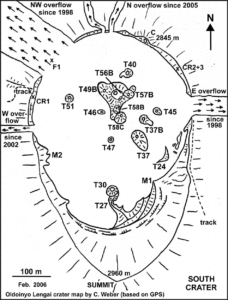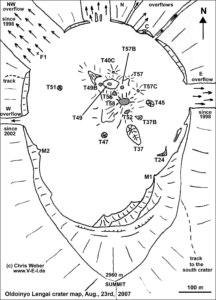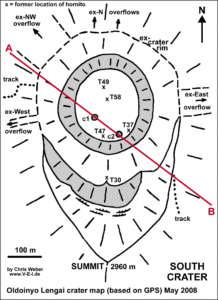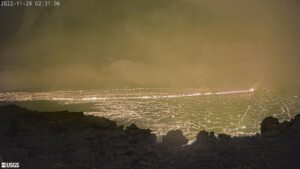 An eruption began at Mauna Loa in Hawaii. Around 11:30 p.m. HST (10:30 a.m. UCT), an eruption fissure opened in the Moku’āweoweo summit caldera. Lava is erupting from it, flooding the floor of the caldera. The activity is so far limited to the summit caldera and does not pose a threat to residents. Nevertheless, the alert status has been raised to “red.” Volcanologists emphasize that winds may blow volcanic gases and possibly fine ash and Pele’s hair. Health authorities are in close contact with the HVO and close monitoring is being done to see if any health hazard develops for humans and animals. As early as October, residents were warned to prepare for evacuations if a volcanic eruption occurred at Mauna Loa. If cracks form on the volcano’s flanks, then there is danger to residents living near the volcano. Lava at Mauna Loa is usually thin and flows quickly.
An eruption began at Mauna Loa in Hawaii. Around 11:30 p.m. HST (10:30 a.m. UCT), an eruption fissure opened in the Moku’āweoweo summit caldera. Lava is erupting from it, flooding the floor of the caldera. The activity is so far limited to the summit caldera and does not pose a threat to residents. Nevertheless, the alert status has been raised to “red.” Volcanologists emphasize that winds may blow volcanic gases and possibly fine ash and Pele’s hair. Health authorities are in close contact with the HVO and close monitoring is being done to see if any health hazard develops for humans and animals. As early as October, residents were warned to prepare for evacuations if a volcanic eruption occurred at Mauna Loa. If cracks form on the volcano’s flanks, then there is danger to residents living near the volcano. Lava at Mauna Loa is usually thin and flows quickly.
 Marc Szeglat
Marc Szeglat
Volcano San Miguel increases activity
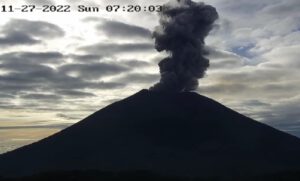 As reported by the government agency MDMA, the volcano San Miguel in El Salcador increased its activity over the weekend and doubled its previous ejection heights of tephra. During particularly strong eruptions, the volcanic ash rose to 1100 m above crater level. The eruptions had a VEI of 1. Nevertheless, the eruptions were described as phreatic. Volcanologists report that they are closely monitoring the volcano’s activity and watching for indications of whether there is a transition to stronger phreatomagmatic eruptions.
As reported by the government agency MDMA, the volcano San Miguel in El Salcador increased its activity over the weekend and doubled its previous ejection heights of tephra. During particularly strong eruptions, the volcanic ash rose to 1100 m above crater level. The eruptions had a VEI of 1. Nevertheless, the eruptions were described as phreatic. Volcanologists report that they are closely monitoring the volcano’s activity and watching for indications of whether there is a transition to stronger phreatomagmatic eruptions.
Mount Etna opened new Vent
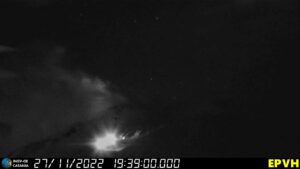 Yesterday evening, Etna opened a vent at the base of the Southeast Crater cone. On the LiveCam you can see a bright spot coming from a short lava flow. According to INGV, the vent opened at 17:00 in the northeast, at an altitude of 2800m. We have observed similar events several times in the last years. Often there was a paroxysm after a few days of lava flow activity. Tremor and seismicity are so far inconspicuous, the lava seems to escape without much pressure. It is quite possible that this is the material that intruded under the crater 2 weeks ago.
Yesterday evening, Etna opened a vent at the base of the Southeast Crater cone. On the LiveCam you can see a bright spot coming from a short lava flow. According to INGV, the vent opened at 17:00 in the northeast, at an altitude of 2800m. We have observed similar events several times in the last years. Often there was a paroxysm after a few days of lava flow activity. Tremor and seismicity are so far inconspicuous, the lava seems to escape without much pressure. It is quite possible that this is the material that intruded under the crater 2 weeks ago.
Cotopaxi in Ecuador erupted volcanic ash
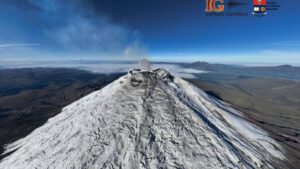 On Thursday morning, many astonished eyes turned in the direction of the Cotopaxi summit, because at night there must have been an ash eruption that turned the snow at the volcano’s summit gray. The volcanologists from IG go wrote in their report that it was only a small ash cloud that had risen up to 300 m above crater level. It is believed that the ash was produced in an exhalation that also emitted a lot of gas. A clue to the exhalation was provided by a weak tremor signal recorded by seismographs around 6:30 p.m. local time. Although it was only a small eruption, the activity worries the people of the region. Cotopaxi is the second highest volcano in Ecuador and one of the highest active fire mountains on Earth. The Andean volcano rises 5897 meters above sea level and its summit area is covered by a glacier. Therein also lies the greatest danger of Cotopaxi, because large eruptions could melt the ice, creating lahars. They could reach the suburbs of Quito, because the capital of Ecuador is only 50 km away from the volcano.
On Thursday morning, many astonished eyes turned in the direction of the Cotopaxi summit, because at night there must have been an ash eruption that turned the snow at the volcano’s summit gray. The volcanologists from IG go wrote in their report that it was only a small ash cloud that had risen up to 300 m above crater level. It is believed that the ash was produced in an exhalation that also emitted a lot of gas. A clue to the exhalation was provided by a weak tremor signal recorded by seismographs around 6:30 p.m. local time. Although it was only a small eruption, the activity worries the people of the region. Cotopaxi is the second highest volcano in Ecuador and one of the highest active fire mountains on Earth. The Andean volcano rises 5897 meters above sea level and its summit area is covered by a glacier. Therein also lies the greatest danger of Cotopaxi, because large eruptions could melt the ice, creating lahars. They could reach the suburbs of Quito, because the capital of Ecuador is only 50 km away from the volcano.
Shiveluch erupts volcanic ash
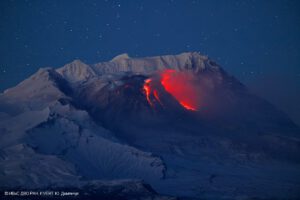 On Kamchatka, the Shiveluch is erupting volcanic ash. According to VAAC, it rises to an altitude of 4000 m and drifts towards the east. KVERT attests that the volcano has increased activity and indicates that the dome continues to grow. MIROVA detects moderate thermal radiation. Red glow is visible at night and incandescent debris avalanches are coming off. Activity may continue to increase, producing pyroclastic flows. The photo was taken on 19 November by Yu. Demyanchuk (KVERT).
On Kamchatka, the Shiveluch is erupting volcanic ash. According to VAAC, it rises to an altitude of 4000 m and drifts towards the east. KVERT attests that the volcano has increased activity and indicates that the dome continues to grow. MIROVA detects moderate thermal radiation. Red glow is visible at night and incandescent debris avalanches are coming off. Activity may continue to increase, producing pyroclastic flows. The photo was taken on 19 November by Yu. Demyanchuk (KVERT).
Volcanoes of east Africa
Adventures around the volcanoes of East Africa
Author Chris Weber
The Virunga Volcanoes (1996 and 2011)
Oldoinyo Lengai: The holy mountain of the Masai (1996 until 2008)
Erta Ale and the Danakil (2002 until 2016)
African Rift Valley East
The East African Rift system extends from the Jordan Valley through the Red Sea, southwards through East Africa and then along the Zambezi River. This system is about 6500 km long. The active continental rift volcanism in East Africa created great faults with an average width of 50-60 km. In places, parts of the earth’s crust has sunk, while in other places the edges of the trench has been lifted up.
As a result, the altitude of the bottom of the trench varies from 600-900 meters below the trench shoulders. In some areas this difference in altitude is even up to 3000 meters. Sediments and lava have partially filled the rift over millions of years.
Turning inland from the Red Sea into Ethiopia, the rift is dividing the country into the highlands to the west and lower desert to the east. Then in Kenya and Uganda two separate branches go apart and join together at their southern end in southern Tanzania along its border with Zambia. The Western Rift is also called the Albertinen Rift, including the Ruwenzori Range, plus the Mitumba and Virunga Mountains. The deepest valleys are found to the north of Kenyas capital Niarobi.
The most of the great rift lake was formed as the result of the rift-system, and lies in territories within the rift. Lake Victoria is considered to be part of the rift-valley-system, although its found actually between the two rift branches. The most rift lakes have high mineral contents as result of evaporation of water, like Lake Magadi with a high concentration of soda, meanwhile Lake Bogoria and Lake Natron are all strongly alkaline, while freshwater springs who supply the lake Naivasha do support the current biological variety. The southern section of the Rift Valley with lake Malawi hosts the third deepest freshwater lake in the world and reaches 706 metres surface to bottom.
The two major gateway-towns of the East African Rift are Nairobi in Kenya and Addis Abeba in Ethiopia.
Continental Rift Volcanism
The East African Rift is the most important example of continental rift volcanism. Another good example is the Upper Rhein Graben (rift) in Germany. But much more widespread or predominant on Earth is the mid-ocean rift volcanism usually deep down in the oceans. This is the same geophysical principle of earth plates drifting apart, but differs in the uplifting rock melt (magma).
Continental rift volcanism arises where convection currents in the interior of the earth drive the continental lithospheric plates (earth’s crustal plates) apart. The so formed fracture gaps are then filled up with volcanic products from the earth’s interior. Volcanoes arise and floods of magma pour into the fractures as viscose lava flows.
This process can stretch over hundreds of millions of years and might be accompanied by epochs of immobility. With the current examples of the East African Rift and the Upper Rhein Rift, which today are apparently subject to a small spreading scale, nevertheless, one day the subcontinent could migrate apart so that a new ocean is created.
Adventures around the volcanoes of East Africa
The Virunga volcanoes (1996 and 2011)
Part 1: Gorillas of Zaire (Rep. Kongo)
After I had eaten dust being whirled up by some UN trucks with goods for the refugees in Goma, while sitting on an open pickup truck which had given me a lift, public transport stopped finally at the frontier-post between Uganda and East Zaire. So I had to hire a local guide to continue on foot. We went through lush farmland up on the slopes of Sabinyo volcano.
This mountain and the neighboring Virunga volcanoes of Muhavura, Gahinga, just north of Sabinyo, and Visoke, Karisimbi (the highest with 4507m) and Mikeno to the south, give home to the last about remaining 600 mountain gorillas (Gorilla beringe). They hide at higher altitudes of those volcanoes in the tropical so called cloud forest, forming a fairly tale scenic atmosphere.
One day of hard and rough walking along narrow footpaths, luckily free of landmines, brought me up to the cloud forest line of Mikeno. There I had to pay a 130 US fee cash at the basic ranger station to take off the next day visiting the gorillas with an armed patrol. Well, good invested money, to keep the primates protected against poachers, hungry sodliers or refugees. Therefore most of the gorilla families have armed rangers living with them all along the time.
It was early morning when we took off into the mysterious jungle, following the gorillas tracks through thick forest for hours. Finally we arrived at an opening where a big family group of 25 gorillas were feeding and relaxing. A half ton silver back, hat of this group, washed from time to time, while gorilla babies were coming closer to check my photo equipment and my laces. After two hours or so, we left these nice creatures excited and fascinated.
I walked down from these volcanoes and met the paved road to Goma, when an overloaded pickup truck stopped to pick me up. Our truck got stopped three times on a few kilometers and on the third stop zairen soldiers ordered me to hop of. The driver of the truck said sorry drove off. I know, that the zaire soldiers got paid by their government in invalided money such as the Zaire and that’s because of hunger they kill wild animals and steal in villages, even once they looted and ruined Goma.
So, I was quite nervous when some lousy looking soldiers escorted me in a dark hut of the road, standing in front of a greening hire raked officer. I explained, that the only reason to come here was the attempt to climb the volcano Nyiragongo, that´s why I was wearing military boots. I knew ahead, that these shoes would have had brought some trouble to me in East Africa. So I had to pay my way out by little cash and cigarettes. John, a local translator for care-oganisations and journalist told me some days later in Goma, that it’s impossibile to get any kind of good shoes around Goma.
In the surrounding of Goma huge refugee camps with kilometers of space hosted some hundreds of thousands of Hutus who had started an exodus from Ruanda into Zaire in the 1970’s after first massacres took place by the Tutsi minority. Then, after many incidences 1994, the Hutu took revenge and killed 75 percent of the Tutsi and moderate Hutus. Alone in June and July up to 1 million people were killed. Finally, the rebel group RPF took over in Ruanda and installed a Tutsi government again, causing countless Hutu to flee out of the country.
Part 2: Nyiragongo volcano hike
There was little to say about Goma itself, because this ruined town was a total mess with hotels and restaurants closed, shops emty and an UN oganisation (pease and aid force) behind many high fence lines. After one night in Goma without any food except Coca Cola, and went out on the road again ot reach the foot of Nyiragongo. It was out of the question to clime up the volcano without guide an armed force, because of gang (bandits) actyvities around volcanoes such as RPF rebels and others.
So I went to the national park headquarter asking for help. Two remained officers were surprised to see me as a visitor, but the very nice Mr. Kivuya Wa Viui agreed to join me up the volcano after a long conversation and after paying the 100 US fee for hiking the mountain, plus some extra for my guide. Maybe the only incoming for Kivuya since many mounth. At a nearby zairen military post we founed luckely a solution get a well armed group. The chef officer was so amazed of my crazy wish to clime Nyiragogo, that he ordered a docent soldiers for this expedition.
I wasn’t really sure about of putting my life and my army boots into the hand of a group of Rambos with no shoes. Well, there was one more problem, my leeck of any food. But after checking this jung guys out and the fact, that this forest are hiding places for Hutu and Titsi, gave me no other option. For this evening Mr. Kivuay gave me some food and a place to lay dowen my sleeping bag.
Our expedition started by early morning it was best armed with an amazing viorty of weaponds. Soon we entered the jungle at its best with heat, humidity crying monkeys and crazy loud zikades. During a brack, I pulled out my foto camera and instandly watched into the soldies big eyes. Well, for sure it was in their eyes a fortioned. But they made jokes about in the next minute and asked for a group picture all together. Then they gave me some of their food, an unkowen paste of sweet rood.
We walked up a slippy path under combat conditions with one little group well ahead of us, when suddenly loud gun fire started. I stopped breathing, went down and listened, meanwhile some soldiers rushed up the path. The exosting trecking was forgotten for the monemt. I look to Kivuay next to me. He was shaking his head and asked a soldier with whispering voice. Then he greened to me and explained, that it was just a salute for a shot comrade a while ago. Well thanks, thought I.
We reached a hut half an hour below the crater rim after 5 hrs. of tracking. Me and the armed ranger Kivuay agreed that the soldiers would retuned slowly back down the volcano. No, rebels, they said, not asking for a single Dollar. Well, only bush land was on the upper slopes of 3470 m high Nyiragongo, and it was quite cold already. Mr. Kivuay and I went up to the crater rim for some hours, so that I could document the geological situation of the volcano.
For this night we returned to a little and cold hut with open door and window. It was aufull only wirh a bed of leaves. The following morning we went up again for some pictures, then we started our descent. Half way douwn Kivuay pulled me of the track deep into the bushes and me getting doon and being quide, so did I. Some sldiers pass by. At the ranger post Kivuay explaned to me, that he was afrait of frandly fire. I left my body with an extra tip, paid my way via Goma to the frontier of Ruanda.
Part 3: Through Ruanda
Crossing for Zaire into Ruanda these days mend unpacking the backpack at cable military checkpoint and explaining my reason of travel, as well why I carried a meter long bush knife (sometimes I asked myself too) and what I’m supposed to do with my photo camera. I maganed anrgy and swetting to anwers this and reached the border town Gisenyi, got a hotl and some food, A riseing dawn I wend out to take a few pitures of destroyed military machenery from the Ruanades conflic, well knowing that I had to be carefully by doing this. But the treets were emty in my opinion, so I took pictures.
When I start to walk back two military guys came across towards me. Oh oh, I thought. They said, ‘it’s forbidden to take pictures in Gisenyi’ and asked for my camera. I said no and that I was only taking pictures of the sun set over lake Kivu. They escorted me to a closed by police station. A nother military showed and after a discusion they aksed the film roll in my camera. To give the roll away with the of Nyiragogo and Gorillas away was out of the question. We argued I asked of higher rank officer again and again They agreed and two of them wend of.
That was my chance. I said ‘I need to go to toilet’ and to my surprise they had one in the station, even a real flushing one, and let me go. I closed the door, pulled out my camera, flushed the toilet, pushed the rewind button the camera motor did so, took the film roll out, a new inside, closed, flushed again and wend out. The militaries igrored me and the matter facted, that I was swetting like hell. Soon after, an argry officer showed amd asked for the film roll. Well, I took it out and handed over to him, than I left. The laugh was on my side for right now.
There was for sure no photo shop to develop my film roll, to make sure I left Gisenyi at dusk without breakfast on a big truck towards the frontier of Tanzania. Counless military stops and the frontier paper work took me all day long. Luckyly I got a nother truck on the tanzanien side, where a million refugees camped along the road since over two years. In one center of those elend I had to hopp of the truck already by night. So far safe, but hungry and tyred.
The nice truck driver asked for me around where to spend the night. An english speaking guy showed me a splace in a tent and a bessar cinemar where I could founde food and a coke. Maybe 50 relativly previleged or so, wathched quite silently the movie ‘Over the top’ with the actor Silvester Stallone on a small TV. Entrance fee of the cine was a quarter of a Dollar. This unreal, real situation made me some tears comming into me eyes. I left this burned, sad and tortured land towards the Serengeti, crossed the national park and reached the town Arusha, an urban paradise in compare.
Nyiragongo
Abstract
The 3470 m high strato volcano Nyiragongo is part of the Virunga mountains, which consist of 8 volcanoes. One of Africa’s most notable active volcanoes contained a lava lake from time to time in its deep summit crater.This lava lake was exsisting for half a century before outer flanks draining catastrophically in 1977. The steep slopes of a volcano are in contrast to the lower profile of the neighboring shield volcano Nyamuragira to the north. The 1.2 km wide summit crater has benches in the steep walled. Mark levels of former lava lakes, which have been observed since the late 19th century are found. The older strato volcanoes of Baruta and Shaheru are overlapped by the recent Nyiragongo and partially still seen on the north and south. Around 100 parasitic cones are located along radial fissures as far as Lake Kivu to the south. Many cones are buried by lava flows already, that extend long distances down the flanks, In 1977, the extremely fluid lava flows caused many fatalities on the south-east flank. The fluid lava flows towards the south in January 2002, destroyed a major portions of the city of Goma at lake Kivu.
Activity Reports
Observation on 3 August 1996.
Christoph Weber visited the volcano on 3 August 1996 and made a rough sketch map. Weber also saw no new activity. Features in the crater area included a spatter cone, a feature bordered on its S side with a light gray lava flow (dark shading 1). This flow was apparently the last erupted prior to the visit and it still showed fresh-looking flow channels. Weak fumaroles were located along the SE crater’s wall at concentric fractures ~50-150 m below the crater rim. Weber also relayed that seismologist Mahinda Kasereka had seen typical seismicity around this time interval
Members of an SVE excursion who climbed Nyiragongo during the second week of April 1996 found also no visible eruptive activity. They heard from local residents that the eruption that began in June 1994 (BGVN 19:06-19:08) had ended in September 1995. Whether the eruption actually ceased in September 1995 is ambiguous because Dario Tedesco learned that in November 1995 and in February-March 1996 observers saw glow above the crater at night. Also, Tedesco learned that some tourists spending the night near the summit during this same post-September interval allegedly saw minor activity. Some sustained seismic activity was reported in September through early December 1995 (BGVN 21:01).
Figure below: Nyiragongo sketch map showing the crater in August 1996. Symbols are as follows: 1) Spatter cone with last lava flows (shaded); 2) spatter half-cone; 3) first platform (or bench, ~175 m below the crater rim); 4) surface of chilled lava lake and associated lava flows (~275 m below the rim); and 5) dikes. Courtesy of Christoph Weber.
Observations in January 2011. Chris Weber visited Nyiragongo with an expedition group from 19 until 22 Jan. 2011. Lava lake activity of the last years continued into January. The first platform from the eastern crater rim at 3420 m was still ~175 m below and marked the post-1977 level. The lowest platform inside the crater was at 3020 m (level of post-2002), which made a total of ~400 m. A high dynamics lava lake, consisted of the lava fountains, measured roughly 200 diameter and was hosted behind an 20 m high ring wall built by lava spattering.
References
The following references have all been used during the compilation of data for this volcano, it is not a comprehensive bibliography.
Krafft M, 1990. Fuhrer zu den Virunga-Vulkanen. Stuttgart: Ferdinand Enke
Global Volcanism Program (GVP), 1996. Bulletin of Global Volcanism Network (BGVN), Smithsonian Institution
(page 5)
Oldoinyo Lengai: The holy mountain of the Masai (2006 until 2008)
Author Chris Weber
Report on Lengai 2 until 7 February 2006
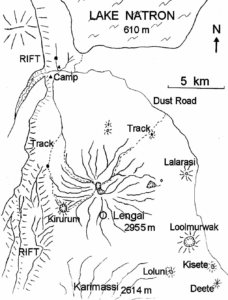 Christoph Weber arrived with a film team at the crater of O. Lengai 1100 on 02 February. C. Weber took scale of the the tallest hornito T49B with approximately 2890 m altitude (GPS) standing ~60 m above the crater floor at the NW overflow at 2830 m. No recent eruption had occured at T49B, but strong noisy degassing took place sometimes. Just east of T49B, the T56B hornito had convecting lava deep inside it’s cone and some lava flows only days old streched from three different vents at T56B towards the east as far as the E overflow. After the major collaps of T56B in 2004, this hornito (standing at approximately 2875 m altitude on 02 Feb.) has nearly grown up again to its former shape and altitude. Also from T58C and the collapsed T58B hornito some lava flows only days old were found on the eastern slopes passing the old and weathered T37, T37B and T45. The caldera shaped collapsed T58B hornito had it’s flat flour at ~2865m altitude with four active vents inside. Lava convection was close to the surface of T58B and depp inside the tall T58C at arrival (1100 hours) on 02 February.
Christoph Weber arrived with a film team at the crater of O. Lengai 1100 on 02 February. C. Weber took scale of the the tallest hornito T49B with approximately 2890 m altitude (GPS) standing ~60 m above the crater floor at the NW overflow at 2830 m. No recent eruption had occured at T49B, but strong noisy degassing took place sometimes. Just east of T49B, the T56B hornito had convecting lava deep inside it’s cone and some lava flows only days old streched from three different vents at T56B towards the east as far as the E overflow. After the major collaps of T56B in 2004, this hornito (standing at approximately 2875 m altitude on 02 Feb.) has nearly grown up again to its former shape and altitude. Also from T58C and the collapsed T58B hornito some lava flows only days old were found on the eastern slopes passing the old and weathered T37, T37B and T45. The caldera shaped collapsed T58B hornito had it’s flat flour at ~2865m altitude with four active vents inside. Lava convection was close to the surface of T58B and depp inside the tall T58C at arrival (1100 hours) on 02 February.
At 1300 on 02 February a sudden increase of activity took place with two lava fountains at T58B lasting only some seconds. At the same time lava spilled out at all T
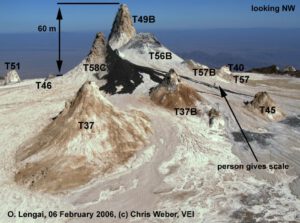
58B vents, a T58C flank vent to the east and at a T56B vent. A lava flow went from T58B ~50 m towards the east. Lava spatter with lava flows inside T58B caldera and up to ~150 m towards the east. Lava spattering and little flows at T58B occured as well the following 3 days. From 0500 until 0730 on 06 February higher activity occured with lava outflow at T58C. T58B showed also a higher activity level from than on until C. Weber and team left the crater on 07 February morning.
Lava temperatur was measured with 519°C at an Aa lava flow with cooled surface and not in motion any more. Fumarol temperatures were measured as well. During an observation flight on 13 February C. Weber noticed new lava flows from T58B and T56B vents.
Report on Lengai 21 and 23 August 2007
With an excursion group Chris Weber started to climb O.Lengai with some local porters on 21 August early morning. With the knowledge of strong effusive eruptions inside the crater and because of clowdy and foggy conditions that day, the porters (some Masai and some of other tribes) were told not to enter the crater without a volcano guide. But some ignored the warning and crossed the crater by themselves, which caused a terrible accident at around 0800 that day. One local Masai fell into a running quite deep lava flow, more than 500 degrees celsius hot. Somehow he managed to get out of the lava, but leaving both legs and one arm of him completely burnt. Half an hour later Chirs Weber arrived with his group at the crater of O. Lengai. The well equipped group started first aid treatment and organized an effective and immediate rescue down the steep volcano slopes with the help of some tough men such as Burra Ami Gadiye and Othman Swalehe. After treatment in Arusha hospital financed by volcano Expedition Int., the Masai was on the way to recover mid of September, which is some kind of a wonder because of his severe burning injuries.
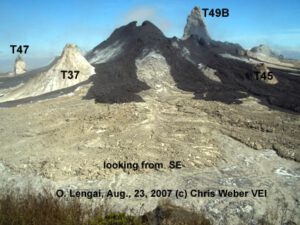 On 23 August Chris Weber and his group reached the crater of O. Lengai at 0815 again. Rough degassing natroncarbonatitic activity from several central vents took place this day. Lapilli and ash was even carried by the wind outside the crater onto the western climbing track. With very good weather conditions Chris Weber took an overview picure of the crater (see image) and a view from the the SE to the central area of hornitos (see image). This eruption period, which started on 20 June, had filled the collapsed central pit area completely with new lava. Some hornitos were grown up again at locations T40C, T52, T58, T57B and new located at T57C and all of those were active with lava degassing and being spitted out. Active lava lakes occurred futher more at the east side of the remaining fragments of the collapsed T49B hornito and at T49 location (see image). The most violent activity occurred on 23 August at T56 located lava lake with lava fountaining up to 40 m high and lapille thrown out even much higher. Lavaflows mainly to the western crater area accompanyed this activity. From 1200 until 1400 massive lava flows drained ouside the crater via the west overflow as far down the volcano slopes as 1500 m altitude.
On 23 August Chris Weber and his group reached the crater of O. Lengai at 0815 again. Rough degassing natroncarbonatitic activity from several central vents took place this day. Lapilli and ash was even carried by the wind outside the crater onto the western climbing track. With very good weather conditions Chris Weber took an overview picure of the crater (see image) and a view from the the SE to the central area of hornitos (see image). This eruption period, which started on 20 June, had filled the collapsed central pit area completely with new lava. Some hornitos were grown up again at locations T40C, T52, T58, T57B and new located at T57C and all of those were active with lava degassing and being spitted out. Active lava lakes occurred futher more at the east side of the remaining fragments of the collapsed T49B hornito and at T49 location (see image). The most violent activity occurred on 23 August at T56 located lava lake with lava fountaining up to 40 m high and lapille thrown out even much higher. Lavaflows mainly to the western crater area accompanyed this activity. From 1200 until 1400 massive lava flows drained ouside the crater via the west overflow as far down the volcano slopes as 1500 m altitude.
Pambao: The expedition in August 2007 to the unusually active Lengai and then the terrible accident in the crater – a Masai porter fell into the lava flow.
Due to the high activity of the volcano, our climb of Lengai was viewed with concern by the Masai. Burra, my loyal companion in recent years, was coordinating and selecting the necessary porters for my expedition group. A young porter had introduced himself as “Pambao”. Although he hadn’t been to the volcano yet, he really wanted to earn the 50 euros for the job to safe it for his upcoming marriage.
During the night, all porters gathered and decided with Burra who had to do what. Water porters were the first climbing to the mountain and were therefore allowed to start at midnight. Due to the activity, my orders for all porters were strictly to wait at the edge of the crater and not to enter it. Also, because the camp site had not yet been pointed out which I would have done after my arrival at the crater rim. Burra translated everything very conscientiously, because he knew the guys very well. For the rest of us, including Burra and some porters for our luggage, the ascent began around 4 am. There was already daylight in the steep upper part when some water porters came down towards us in fear and panic. Burra listened to them and translated their confused chatter, that there was high activity because their god “Engai” seemed to be very angry and due to this an accident had happened. Then they continued their escape down the moutain.
We reached the rim shortly after. There was light fog at the edge where we had arranged to meet but nobody was there. Carefully we entered the crater, starting to walk around to the other side of it, while we heard the violent boiling of the lava from the center of the crater. Then next to a new lava flow we found two porters and Pambao lying on the ground. They explained, that Pambao broke into a 50 cm deep lava flow with a solid, rigid looking surface. Both of his legs to the thighs and one arm to the elbow got seriously burned. He himself was in a shock. Thanks to the nurse Moni in my team and my first aid, we put Pambao on pain medication.
I dindn’t give Pamboa a great chance to survive, but I decided to try everything possible. We built a stretcher out of walking sticks and tarpaulin, then my group members shouldered their own luggage and then descended. Only Burra, my cook Othman, and two “non-Masai” who hadn’t escaped the mountain, remained to bring this poor guy down. This was by far the longest, most strenuous and most dangerous descent from Lengai for all of us.
Pambao reached the hospital in Arusha by car and did miraculously survive financed by us and others. Including Othman we decided to climb Lengai one more time for a whole day, but without any porters.
Report on Lengai 14 until 16 Mai 2008
Summit visit of O. Lengai by Chris Weber and Marc Szeglat, 14 unil 16 May 2008.
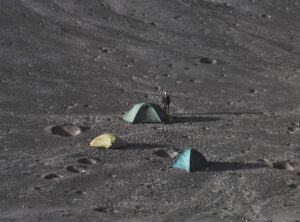 The former common trekking route (track) up O. Lengai is not recommended so far, because of rockfall hazards and bad hiking conditions. We used a very steep route on the SE side (named “simba route”) of the volcano to climb up. From about 1000 m altitude volcanic ash-layers were clearly visible on the ground, but new grass had already grown since the eruption. At approximately 1500 m on the SE- volcano flank, all vegetation started to be covered (or being destroyed) by volcanic pyroclastics (“ash fall out”). From about 2500 m, additional impacts of volcanic bombs were visible. The volcano’s inactive south crater was the location of our camp site. All vegetation was whiped out and volcanic bomb impacts from the last explosive events on April 2008 were quite impressive to study (see images).
The former common trekking route (track) up O. Lengai is not recommended so far, because of rockfall hazards and bad hiking conditions. We used a very steep route on the SE side (named “simba route”) of the volcano to climb up. From about 1000 m altitude volcanic ash-layers were clearly visible on the ground, but new grass had already grown since the eruption. At approximately 1500 m on the SE- volcano flank, all vegetation started to be covered (or being destroyed) by volcanic pyroclastics (“ash fall out”). From about 2500 m, additional impacts of volcanic bombs were visible. The volcano’s inactive south crater was the location of our camp site. All vegetation was whiped out and volcanic bomb impacts from the last explosive events on April 2008 were quite impressive to study (see images).
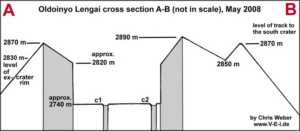 The active north crater of O. Lengai had a new morphology (map and the “cross section”). The diameter of the crater from N to S was 300 m and from E to W 283 m. The crater floor was at approx. 2740 m altitude, accordingly 130 m deep seen form the west crater rim (figure 6. gives scale). Two vents were located as c1 and c2 inside the crater and obviously not at older hornito locations. Both vents were dergassing with strong pressure and quite noisy. On 15 May a period of powder ash eruption started until midday. This happened again on 16 May, unknown which vent was responsible for this. After our descent we visited an abandoned Masai boma on the west side of O. Lengai. The “ash fall” forced the local family Lesele to flee from their home only a few kilometers away form the summit of O. Lengai.
The active north crater of O. Lengai had a new morphology (map and the “cross section”). The diameter of the crater from N to S was 300 m and from E to W 283 m. The crater floor was at approx. 2740 m altitude, accordingly 130 m deep seen form the west crater rim (figure 6. gives scale). Two vents were located as c1 and c2 inside the crater and obviously not at older hornito locations. Both vents were dergassing with strong pressure and quite noisy. On 15 May a period of powder ash eruption started until midday. This happened again on 16 May, unknown which vent was responsible for this. After our descent we visited an abandoned Masai boma on the west side of O. Lengai. The “ash fall” forced the local family Lesele to flee from their home only a few kilometers away form the summit of O. Lengai.
References
The following references have all been used during the compilation of data for this volcano, it is not a comprehensive bibliography.
Bell K, Dawson J B, 1995. Nd and Sr isotope systematics of the active carbonatite volcano, Ol Doinyo Lengai. In: Bell K, Keller J (eds), Carbonatite Volcanism, Oldoinyo Lengai and the Petrogenesis of Natrocarbonatites, Berlin: Springer-Verlag, p. 100-112.
Dawson J B, 1962. The geology of Oldoinyo Lengai. Bull Volcanol, 24: 349-387.
Dawson J B, Keller J, Nyamweru C, 1995. Historic and recent eruptive activity of Oldoinyo Lengai. In: Bell K, Keller J (eds), Carbonatite Volcanism, Oldoinyo Lengai and the Petrogenesis of Natrocarbonatites, Berlin: Springer-Verlag, p. 4-22.
Global Volcanism Program (GVP), 1996. Bulletin of Global Volcanism Network (BGVN), Smithsonian Institution
La Palma: Eruption Cumbre Vieja
Eruption of Cumbre Vieja on La Palma in September 2022
On September 19, 2021, the eruption began on La Palma. In the northwest of Cumbre Vieja opened 2 fissures, each about 200 m long. Lava fountains fed lava flows that reached the settlement of La Paraiso within a few hours. By the following day, more than 100 buildings were destroyed.
The eruption announced itself by a seismic crisis of 8 days duration.
The eruption lasted until mid-December. Within 90 days, lava flows destroyed 2988 buildings and buried 92 km of traffic routes. A lava field with an area of 12.4 square kilometers was created. 494 million cubic meters of lava were produced. This corresponds to 0.494 cubic kilometers, which is already a considerable volume. In historical times, it was the longest eruption of Cumbre Vieja.
This footage was shot in 4 K (UHD).
Hunga Tonga-Hunga Ha’apai: Eruption was very strong
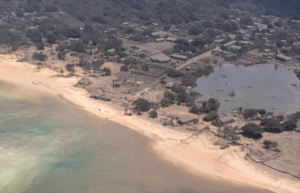 The eruption in Tonga does not want to end. VAAC Darwin registered another eruption cloud over Tonga at 12:00 Zulu time. The altitude indication gives a range between 12,000 and 19,000 m.
The eruption in Tonga does not want to end. VAAC Darwin registered another eruption cloud over Tonga at 12:00 Zulu time. The altitude indication gives a range between 12,000 and 19,000 m.
It is now clear that the damage to the islands of the Kingdom of Tonga is greater than first thought. The tsunamis reached heights of up to 120 cm and caused destruction on the coasts. Most of the islands are covered in volcanic ash and cut off from communication. Saturday’s eruption was also much stronger than initial reports indicated. Volcanic ash was detected at 39 km altitude. The blast wave from the explosion passed around the Earth 4 times.
What made the eruption so strong?
Before the big eruption on Saturday, there were two moderate eruptions and several small ones. The series began on December 20. These eruptions were Surtseyan eruptions in which water already had a hand. Then, in the large eruption, a large amount of seawater probably entered the volcano’s conveyor system and explosively vaporized. Another possibility is that an injection of fresh melt into the magma body occurred, resulting in a reaction between two different magmas. The blast wave from the explosion circled the globe 4 times, causing gravitational shock waves that reached almost into space.
Volcano News 01/14-22: Tonga Hunga
Hunga Tonga-Hunga Ha’apai: Eruption triggers small tsunamis
State: Tonga | Coordinates: -20.545; -175.393 | Eruption: Surtseyan
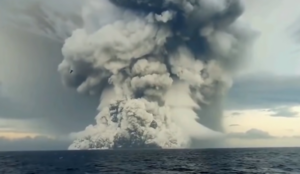 For some days it had become quite quiet around the island volcano Hunga Tonga-Hunga Ha’apai, but yesterday it reported back with a powerful eruption. The volcanic eruption is so strong that small tsunamis arrive on the main island of Tonga. The wave heights are a little less than 60 cm. This may not be much, but even small tsunamis can push a few 100 meters inland and cause damage along the coasts. But there are no reports about that at the moment. In any case, the region is on tsunami alert. The height of the ash column is impressive: according to VAAC Wellington, it rose to almost 18,000 meters. The last detected eruption cloud still reached a height of 15,000 m.
For some days it had become quite quiet around the island volcano Hunga Tonga-Hunga Ha’apai, but yesterday it reported back with a powerful eruption. The volcanic eruption is so strong that small tsunamis arrive on the main island of Tonga. The wave heights are a little less than 60 cm. This may not be much, but even small tsunamis can push a few 100 meters inland and cause damage along the coasts. But there are no reports about that at the moment. In any case, the region is on tsunami alert. The height of the ash column is impressive: according to VAAC Wellington, it rose to almost 18,000 meters. The last detected eruption cloud still reached a height of 15,000 m.
